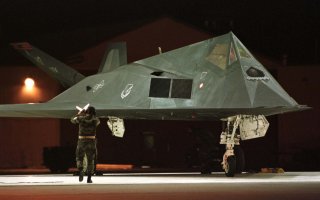The Amazing Story of How a Stealth Fighter Was Shot Down
The F-117’s effectiveness was supported by countermeasures to any prospective missile defense system the plane would meet. For instance, EA-6 Prowler aircraft could be used to electronically jam the missiles’ sensors, and “Wild Weasel” aircraft could target the SAM sites when their radars turned on.
In 1998, following years of unrest and insurgency, an open war began between the government of Serbia, led by Slobodan Milosevic, and the Kosovo Liberation Army, a Kosovar militant group operating in Serbian-controlled Kosovo. Following reports of ethnic cleansing against Albanians in Kosovo, NATO voted to intervene against Milosevic to end the war, and airstrikes on Serbia began on the night of March 24, 1999.
U.S. participation in this campaign was led by the F-117 Nighthawk. The Nighthawk was one of the first true “stealth” aircraft; it had been highly successful during the 1991 Gulf War, and not a single plane had yet been lost.
The F-117’s effectiveness was supported by countermeasures to any prospective missile defense system the plane would meet. For instance, EA-6 Prowler aircraft could be used to electronically jam the missiles’ sensors, and “Wild Weasel” aircraft could target the SAM sites when their radars turned on.
Both of these countermeasures, however, were absent on the night of March 27, when Lieutenant Colonel Dale Zelko took off for Serbia in an F-117 Nighthawk. Moreover, some of the cautions that had been exercised during previous wars had given way to complacency. When F-117s launched raids on Baghdad in 1991, they would never the same flight paths in and out of Iraq. U.S. F-117s in Kosovo and Serbia, on the other hand, would.
And while the F-117 was nominally invisible to radar, it had a fatal flaw; when its bomb bay doors opened, its radar signature expanded, allowing it to be targeted far easier.
The Serbian government was not ignorant of NATO’s advantages, but they also knew that the war was unpopular in the United States. They reasoned that by shooting down a high-profile aircraft such as the F-117, they could embarrass the Clinton administration and force an early end to U.S. involvement.
Therefore, on the night of March 27, the Serbian Army had laid a sophisticated trap for Zelko. Serbian spies stationed in Italy watched NATO planes take off from airbases there. Two separate radar systems were used by the Serbian air defenses. One low-bandwidth radar, the P-18 “Spoon Rest D”, was used to track the F-117; although it could only detect it from 15 miles away and was too imprecise to guide a missile toward it, this radar was nearly impossible to detect by NATO countermeasures, so it could be left on. The second system, the SNR-125 “Neva-Pechora” – or SA-3 “Goa”, to NATO – could be used to guide missiles, but was more vulnerable to attack. Therefore, SNR-125 radars were normally only turned on in short bursts twice a night.
Moreover, there was a margin of error; the SNR-125 could only lock onto the plane if it was within 15 miles. The SNR-125 radar commanded by Colonel Zoltan Dani, which had been placed along the anticipated flight path, turned on twice, to no effect.
But because the spies in Italy had seen no Prowlers take off, Dani decided it was safe to try again. He turned the radar on the third time – and spotted Zelko’s F-117 with its bomb bay doors open.
Two missiles were fired. The first narrowly missed; the second exploded near Zelko’s F-117, downing it.
Zelko parachuted out of the plane; with the aid of a U.S. search-and-rescue team, he was able to narrowly evade Serbian pursuers. While his escape was extremely fortunate for the United States, the event was nonetheless a propaganda coup for Serbia; using sophisticated tactics, they had shot down an advanced U.S. stealth jet, for the first and only time in its history. “Sorry, we didn’t know it was invisible,” a propaganda poster triumphantly proclaimed in the aftermath.
Parts of the downed plane are still visible in the Museum of Aviation in Belgrade. The F-117 was retired in 2008, although some remain operational.
The Kosovo War was not a “good war,” but it had one small silver lining: in 2011, decades after the shootdown, Zelko traveled to Serbia to meet Dani, the man who had shot him down, and the two of them became friends.
Trevor Filseth is a current and foreign affairs writer for the National Interest.

